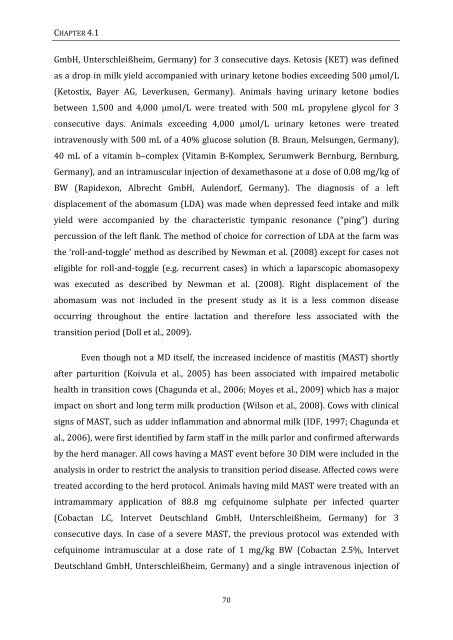view - Department of Reproduction, Obstetrics and Herd Health
view - Department of Reproduction, Obstetrics and Herd Health
view - Department of Reproduction, Obstetrics and Herd Health
Create successful ePaper yourself
Turn your PDF publications into a flip-book with our unique Google optimized e-Paper software.
CHAPTER 4.1<br />
GmbH, Unterschleißheim, Germany) for 3 consecutive days. Ketosis (KET) was defined<br />
as a drop in milk yield accompanied with urinary ketone bodies exceeding 500 µmol/L<br />
(Ketostix, Bayer AG, Leverkusen, Germany). Animals having urinary ketone bodies<br />
between 1,500 <strong>and</strong> 4,000 µmol/L were treated with 500 mL propylene glycol for 3<br />
consecutive days. Animals exceeding 4,000 µmol/L urinary ketones were treated<br />
intravenously with 500 mL <strong>of</strong> a 40% glucose solution (B. Braun, Melsungen, Germany),<br />
40 mL <strong>of</strong> a vitamin b–complex (Vitamin B-Komplex, Serumwerk Bernburg, Bernburg,<br />
Germany), <strong>and</strong> an intramuscular injection <strong>of</strong> dexamethasone at a dose <strong>of</strong> 0.08 mg/kg <strong>of</strong><br />
BW (Rapidexon, Albrecht GmbH, Aulendorf, Germany). The diagnosis <strong>of</strong> a left<br />
displacement <strong>of</strong> the abomasum (LDA) was made when depressed feed intake <strong>and</strong> milk<br />
yield were accompanied by the characteristic tympanic resonance (“ping”) during<br />
percussion <strong>of</strong> the left flank. The method <strong>of</strong> choice for correction <strong>of</strong> LDA at the farm was<br />
the ‘roll-<strong>and</strong>-toggle’ method as described by Newman et al. (2008) except for cases not<br />
eligible for roll-<strong>and</strong>-toggle (e.g. recurrent cases) in which a laparscopic abomasopexy<br />
was executed as described by Newman et al. (2008). Right displacement <strong>of</strong> the<br />
abomasum was not included in the present study as it is a less common disease<br />
occurring throughout the entire lactation <strong>and</strong> therefore less associated with the<br />
transition period (Doll et al., 2009).<br />
Even though not a MD itself, the increased incidence <strong>of</strong> mastitis (MAST) shortly<br />
after parturition (Koivula et al., 2005) has been associated with impaired metabolic<br />
health in transition cows (Chagunda et al., 2006; Moyes et al., 2009) which has a major<br />
impact on short <strong>and</strong> long term milk production (Wilson et al., 2008). Cows with clinical<br />
signs <strong>of</strong> MAST, such as udder inflammation <strong>and</strong> abnormal milk (IDF, 1997; Chagunda et<br />
al., 2006), were first identified by farm staff in the milk parlor <strong>and</strong> confirmed afterwards<br />
by the herd manager. All cows having a MAST event before 30 DIM were included in the<br />
analysis in order to restrict the analysis to transition period disease. Affected cows were<br />
treated according to the herd protocol. Animals having mild MAST were treated with an<br />
intramammary application <strong>of</strong> 88.8 mg cefquinome sulphate per infected quarter<br />
(Cobactan LC, Intervet Deutschl<strong>and</strong> GmbH, Unterschleißheim, Germany) for 3<br />
consecutive days. In case <strong>of</strong> a severe MAST, the previous protocol was extended with<br />
cefquinome intramuscular at a dose rate <strong>of</strong> 1 mg/kg BW (Cobactan 2.5%, Intervet<br />
Deutschl<strong>and</strong> GmbH, Unterschleißheim, Germany) <strong>and</strong> a single intravenous injection <strong>of</strong><br />
70









